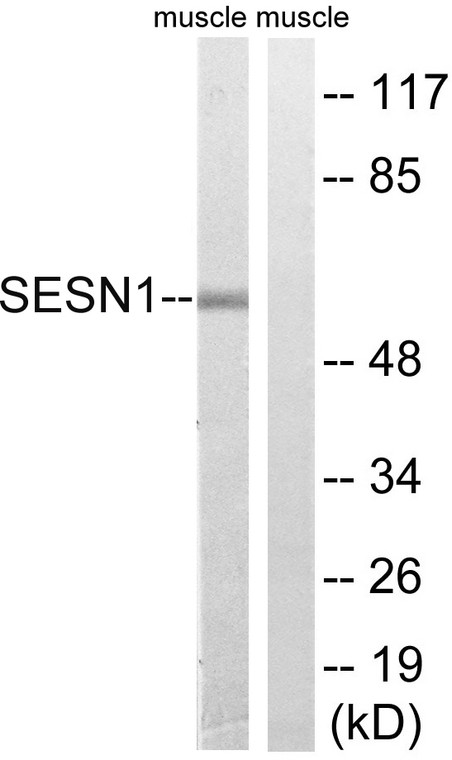| Host: |
Rabbit |
| Applications: |
WB/IHC/IF/ELISA |
| Reactivity: |
Human/Mouse/Rat |
| Note: |
STRICTLY FOR FURTHER SCIENTIFIC RESEARCH USE ONLY (RUO). MUST NOT TO BE USED IN DIAGNOSTIC OR THERAPEUTIC APPLICATIONS. |
| Short Description: |
Rabbit polyclonal antibody anti-Sestrin-1 (271-320 aa) is suitable for use in Western Blot, Immunohistochemistry, Immunofluorescence and ELISA research applications. |
| Clonality: |
Polyclonal |
| Conjugation: |
Unconjugated |
| Isotype: |
IgG |
| Formulation: |
Liquid in PBS containing 50% Glycerol, 0.5% BSA and 0.02% Sodium Azide. |
| Purification: |
The antibody was affinity-purified from rabbit antiserum by affinity-chromatography using epitope-specific immunogen. |
| Concentration: |
1 mg/mL |
| Dilution Range: |
WB 1:500-1:2000IHC 1:100-1:300ELISA 1:20000IF 1:50-200 |
| Storage Instruction: |
Store at-20°C for up to 1 year from the date of receipt, and avoid repeat freeze-thaw cycles. |
| Gene Symbol: |
SESN1 |
| Gene ID: |
27244 |
| Uniprot ID: |
SESN1_HUMAN |
| Immunogen Region: |
271-320 aa |
| Specificity: |
PA26 Polyclonal Antibody detects endogenous levels of PA26 protein. |
| Immunogen: |
The antiserum was produced against synthesized peptide derived from the human SESN1 at the amino acid range 271-320 |
| Function | Functions as an intracellular leucine sensor that negatively regulates the TORC1 signaling pathway through the GATOR complex. In absence of leucine, binds the GATOR subcomplex GATOR2 and prevents TORC1 signaling. Binding of leucine to SESN2 disrupts its interaction with GATOR2 thereby activating the TORC1 signaling pathway. This stress-inducible metabolic regulator may also play a role in protection against oxidative and genotoxic stresses. May positively regulate the transcription by NFE2L2 of genes involved in the response to oxidative stress by facilitating the SQSTM1-mediated autophagic degradation of KEAP1. Moreover, may prevent the accumulation of reactive oxygen species (ROS) through the alkylhydroperoxide reductase activity born by the N-terminal domain of the protein. Was originally reported to contribute to oxidative stress resistance by reducing PRDX1. However, this could not be confirmed. |
| Protein Name | Sestrin-1P53-Regulated Protein Pa26 |
| Database Links | Reactome: R-HSA-5628897Reactome: R-HSA-9639288Reactome: R-HSA-9755511 |
| Cellular Localisation | NucleusCytoplasm |
| Alternative Antibody Names | Anti-Sestrin-1 antibodyAnti-P53-Regulated Protein Pa26 antibodyAnti-SESN1 antibodyAnti-PA26 antibodyAnti-SEST1 antibody |
Information sourced from Uniprot.org
12 months for antibodies. 6 months for ELISA Kits. Please see website T&Cs for further guidance








